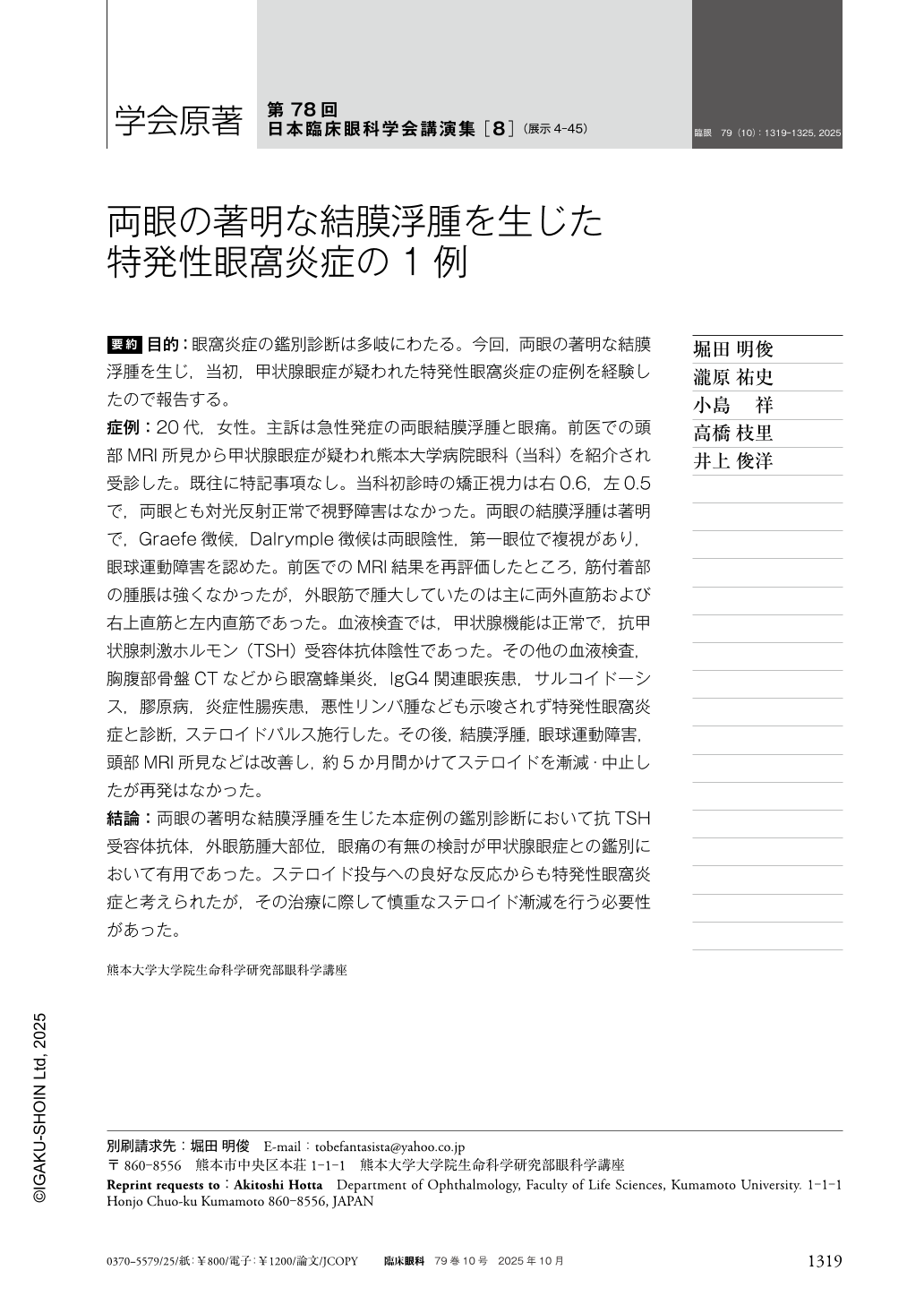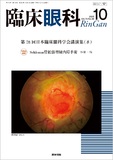Japanese
English
- 有料閲覧
- Abstract 文献概要
- 1ページ目 Look Inside
- 参考文献 Reference
要約 目的:眼窩炎症の鑑別診断は多岐にわたる。今回,両眼の著明な結膜浮腫を生じ,当初,甲状腺眼症が疑われた特発性眼窩炎症の症例を経験したので報告する。
症例:20代,女性。主訴は急性発症の両眼結膜浮腫と眼痛。前医での頭部MRI所見から甲状腺眼症が疑われ熊本大学病院眼科(当科)を紹介され受診した。既往に特記事項なし。当科初診時の矯正視力は右0.6,左0.5で,両眼とも対光反射正常で視野障害はなかった。両眼の結膜浮腫は著明で,Graefe徴候,Dalrymple徴候は両眼陰性,第一眼位で複視があり,眼球運動障害を認めた。前医でのMRI結果を再評価したところ,筋付着部の腫脹は強くなかったが,外眼筋で腫大していたのは主に両外直筋および右上直筋と左内直筋であった。血液検査では,甲状腺機能は正常で,抗甲状腺刺激ホルモン(TSH)受容体抗体陰性であった。その他の血液検査,胸腹部骨盤CTなどから眼窩蜂巣炎,IgG4関連眼疾患,サルコイドーシス,膠原病,炎症性腸疾患,悪性リンパ腫なども示唆されず特発性眼窩炎症と診断,ステロイドパルス施行した。その後,結膜浮腫,眼球運動障害,頭部MRI所見などは改善し,約5か月間かけてステロイドを漸減・中止したが再発はなかった。
結論:両眼の著明な結膜浮腫を生じた本症例の鑑別診断において抗TSH受容体抗体,外眼筋腫大部位,眼痛の有無の検討が甲状腺眼症との鑑別において有用であった。ステロイド投与への良好な反応からも特発性眼窩炎症と考えられたが,その治療に際して慎重なステロイド漸減を行う必要性があった。
Abstract Purpose:The differential diagnosis of orbital inflammation is diverse. Here, we report a case of idiopathic orbital inflammation with marked conjunctival edema in both eyes, initially suspected as Graves' ophthalmopathy.
Case:A female in her 20s presented with acute-onset bilateral conjunctival chemosis and ocular pain. The previous physician suspected Graves' ophthalmopathy based on head MRI findings, and she was referred to our department. She had no significant past medical history. At the initial visit, her corrected visual acuity was 0.6 in the right eye and 0.5 in the left eye. Pupillary light reflexes were normal and no visual field defects were observed in both eyes. Bilateral conjunctival chemosis was remarkable, but Graefe's sign and Dalrymple's sign were negative in both eyes. Diplopia was present in the primary gaze position, and ocular motility impairment was observed. When we reevaluated the previous MRI results, we found that while the swelling at the muscle attachment sites was not remarkable, the enlarged extraocular muscles were primarily both lateral rectus muscles, the right superior rectus muscle, and the left medial rectus muscle. Blood tests showed normal thyroid function and negative anti-TSH receptor antibodies. Additional blood tests, as well as chest, abdominal, and pelvic CT scans, did not suggest orbital cellulitis, IgG4-related ophthalmic disease, sarcoidosis, collagen disease, inflammatory bowel disease, or malignant lymphoma. Based on these findings, the patient was diagnosed with idiopathic orbital inflammation and treated with steroid pulse therapy. Following the treatment, her conjunctival chemosis, ocular motility impairment, and MRI findings improved. Steroid therapy was gradually tapered over approximately five months and discontinued without relapse.
Conclusion:In the differential diagnosis of this case with marked bilateral conjunctival chemosis, the evaluation of anti-TSH receptor antibodies, the location of extraocular muscle enlargement, and the presence or absence of ocular pain were useful in distinguishing it from Graves' ophthalmopathy. The favorable response to steroid therapy supported the diagnosis of idiopathic orbital inflammation and careful tapering of steroids was necessary during treatment.

Copyright © 2025, Igaku-Shoin Ltd. All rights reserved.


